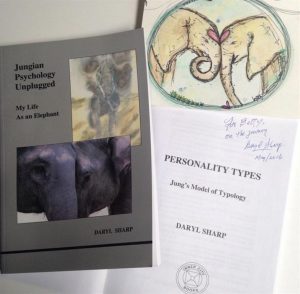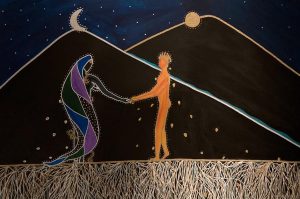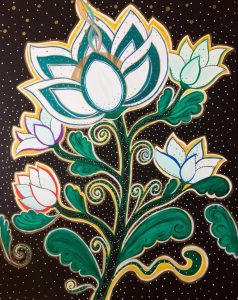by Betty Paz
What is in-depth work like from an artist’s perspective? This is what I’m here to share. Before I
get into the details of my creative process I have to go back in time a few years ago when it all
started. Bear with me as I take you briefly through my journey, with some of the people, places,
and books that have been a source of support, guidance, and inspiration.
Before I begin, I would like to say that it is an honour for me to be a guest writer on the ICB
blog. I have such respect and gratitude for the work of C.G. Jung, Marie-Louise von Franz, and
the first and second generation of Jungians. I have a preference for the fertile, profoundly rich,
and nurturing soil of the origins of what is now considered classical Jungian psychology.
My journey began in Venezuela, my first home, when I knocked on the door of my then-Jungian
analyst (soon to become a lifelong friend) Beatriz Rojas, a remarkable intuitive woman. Little
did I know that by knocking on her door I was going to enter a new dimension of myself. During
my time in analysis I worked with mandalas (which appear spontaneously), dreams and active
imagination. I was also introduced to my first Jungian book, as Beatriz, guided by a dream, asked
me to translate for her “On Mandala Symbolism” written by C.G. Jung and found in the
Collected Works, Vol. 9-1. I devoured the book and that was the beginning of my relationship
with Jungian psychology. A flame was lit that could not be put out when life made sense for the
first time.
A few months passed and I found myself moving to what would become my second home,
Canada, where I would continue to be an avid reader of Jung. I kept finding his books at the
second hand store in the small town I lived in at the time (Canmore, AB). I also bought the Red
Book as soon as it came out, and continue to paint mandalas from time to time. But it wasn’t until
eight years ago and after a significant encounter, that I really started looking inward, and I
haven’t stopped since. I consider this the moment where my individuation process really began to
develop. The result is what I called Archetypal Art today, more on that later.
Then came Toronto. My first visit to TO came at a time when my art consisted mainly of abstract
paintings and illustrations, particularly elephants. As I was getting ready to leave I stumbled
upon a new podcast with interviews of Jungian analysts and listened to the episode with Daryl
Sharp. As soon as I heard his story about elephants, I knew I needed to contact him and buy his
book ICB titled 80 Jungian Psychology Unplugged: My Life As an Elephant. I went to Toronto
with some elephant illustrations (one especially for Daryl) and the first 12 images of my
Archetypal Art, these images I knew were different from my previous work. Once in Toronto I
called ICB and to my surprise Daryl answered the phone! As suggested by a dear friend (can’t
take credit for that), I told him I came from the prairies (Winnipeg, MB) knowing he was from
Saskatchewan and made an appointment to buy his book and meet him.
I arrived at the original ICB headquarters a few minutes earlier than expected, the meeting was at 4 o’clock and Daryl was already waiting as he soon let me know. I still remember the gargoyles, the feeling of being in a book, and Daryl opening the door and saying my name “Betty…” taking the fairy tale atmosphere to another level. I asked him if I could show him my artwork and he replied “You have five minutes”. My natural reaction was to exclaim “Five minutes! That’s not enough time!”… He found this amusing and said, “Okay, 25 then…” We moved into the living room where I saw all the elephants people had given him over the years. We had a good conversation. He looked at my elephants, we talked about the synchronicity that lead to this experience among other things, and he finally saw my Archetypal Art… There was a pause, he looked into my eyes with the spark that tells you that you are sharing something meaningful and
it is understood, no words needed. I gave him one of my elephants as a thank you and he gave me ICB Title 31 in return (written by him) Personality Types: Jung’s Model of Typology. That was truly a milestone, with the significant reminder of the words “on the journey” that he kindly
wrote in the book…and so I went.
My life, like the life of anyone who is serious about inner work, began to take interesting but also
challenging turns. At times I wasn’t sure what was happening or if I could continue, but the
desire to create and survive was always stronger, and it almost felt like my soul was demanding
that I continue painting my experience. Although I was no longer in analysis, I was lucky to have
someone to help me stay grounded as my journey became deeper and more complex. It was
around this time that I once again listened to another episode of the Speaking of Jung podcast,
but now the guest was J. Gary Sparks. You may know him by the ICB titles 119 At the Heart of Matter: Synchronicity and Jung’s Spiritual Testament, 127 Valley of Diamonds: Adventures in Number and Time with Marie-Louise von Franz, 145 Carl Jung and Arnold Toynbee: The Social Meaning of Inner Work, and more recently title 146 The Call of Destiny: An Introduction
to the Major Works of Carl Jung… and following The Call of Destiny I contacted Gary. Something
inside me knew that I had to talk to him about my art. I was already a bit bummed out to be
honest, because not everyone in the Jungian community understands or appreciates the
importance of working with images which Jung emphasized so much, but in my heart I always
knew that a true Jungian analyst would recognize that. Beatriz and Daryl were proof of this and
soon Gary will join them.
There is so much I could say and it would never be enough about J. Gary Sparks and the impact
he has had on my life and creative work, as it is through my invaluable friendship with him that I
can say I was able to truly dive in and face the most disturbing moments, pain, sacrifices and
challenges of a path that helped me mature and experience the growth of the soul’s flower. I
would not be who I am today without him.
Eros is at the center of my creative work and this story, the people we meet, the meaningful
encounters, those who really see us and leave us no choice but to face ourselves. In-depth work
is painstaking work, it is serious work that demands commitment, since the soul is not satisfied
with anything else but the uniqueness of what and who you are, and what you can bring to the
world. It is a humbling experience that brings you to your knees so that you can begin to grow
from the bottom up. Gary writes in The Call of Destiny: “In other words, genuine personhood,
real selfhood, has to do with the discovery that slumbering in the unconscious is the pattern of
our life waiting for us to realize it, to bring into time and space the unique individuality we are to
develop and the unique contributions that we are to bring into life.”
As an artist the drive to create, to birth inner visions, sometimes overrides basic needs. Jungian psychology has helped me navigate, integrate, understand, accept, and enhance my vocation by establishing a relationship with the soul.
Jung made a distinction about how to treat or relate to a creative individual, Gary knew this from the beginning and immediately had me look at the opus of artist Peter Birkhäuser, opening the door to my deep love and respect for his work. Birkhäuser was in analysis for more than 30 years with Marie-Louise von Franz and also shared his work with Jung. In his paintings I have found solace and a source of confirmation and support, to say the least. His work is a treasure for humanity. His wife Sybille is also the author of one of my favourite ICB books, title 34 The Mother: Archetypal Image in Fairy Tales.
So, how is my creative process now and what do I call Archetypal Art?
What started with seven images depicting patterns in the structure of the human psyche has now grown to 256. The images are divided into groups, each showing a different stage of development. They have become a constant memory of every moment lived, every experience, every feeling, every emotion, every desire as I struggled to understand myself and have a relationship with the Self. I recently added a new group, Post-Archetypal Art, which represents the patterns of the individual journey. So it could be said that Archetypal Art is the collective patterns and Post-AA the individual ones. That there is a pattern of the individual journey, the one in which you become what you are destined to be from before you came into the world becomes evident when deep and extensive work is done as Jung told us, and that is the individuation process.
The relationship between instincts and archetypes, the image-making function of the psyche, the
symbolic language of the soul and what happens when we start to remember it, among many
things, is highly developed on the pages of all ICB titles. The beauty for me is that each title is
written from the perspective of the Jungian analyst and how they experienced and understood
themselves and their process… How precious and unique. In his latest book and ICB comeback
title, J. Gary Sparks elaborates on “the forward striving function” of the psyche and how each
image, when followed, is a continuation of the one before… and that’s what my Archetypal Art is
all about. I am here to share the images, the eros, the colours of what you read about in books as
a result of my experience.
My creative process is a form of active imagination, it is a sacred time that I spend with myself, a conversation… and it goes something like this:
During my process, the images manifest themselves in different ways … at random moments … sometimes they appear in dreams, other times it will be a vision when waking up or when having a shower….or cooking… or driving. The image won’t let go of me until I sit down to draw it or paint it. It may be a shape or light or colours that take a specific form once I sit down in front of a piece of paper or canvas. I don’t think about what I want to create, it comes to my awareness when I’m ready to receive it … and become conscious of it. During the process of creation, I pay attention to which part of my body is this image connected to, is it my lower abdomen? stomach? chest, head?… After I finish creating the image, I proceed to contemplate it and continue interacting with it for days. At times I will go to bed exhausted after hours of painting and wake up in the morning with more insights. Another thing I do is amplify the content of my image by reaching out to one of Jung’s books or the book I feel compelled to. Then I try to put this into context with my current situation. Other times I’m reading Jung and the images start coming to mind as a reflection of what I’m reading.
“That is what Jung means by a “meeting or union of conscious and unconscious”—in other
words, an understanding on the part of consciousness of the meaning of the image which is
generated from within the unconscious. We need these images to reorient us so we can go
forward to the fulfillment of our destiny, that destiny coming to us piece by piece in the images
we find in the descent into the unconscious.” J. Gary Sparks, The Call of Destiny.
My Archetypal Art is available to anyone on my website for contemplation and study purposes,
as well as the mandala art sessions I offer to anyone interested as I not only paint mandalas for
myself but also for others.
This is my journey, the story of how I came to know the work of C.G Jung, how I met Daryl
Sharp, J. Gary Sparks, how I matured psychologically/spiritually and creatively, by following the
calling of my soul. As my soul would say “There is a lineage and you found it”. Daryl and Gary’s
training was that of a knight, like pillars guarding the mystery of the human soul… I’ve been
fortunate to have absorbed some of it.
ICB’s books are timeless treasures waiting for anyone “on the journey.” May you all find your
way back to nature, to your soul and continue to keep the flame alive.


